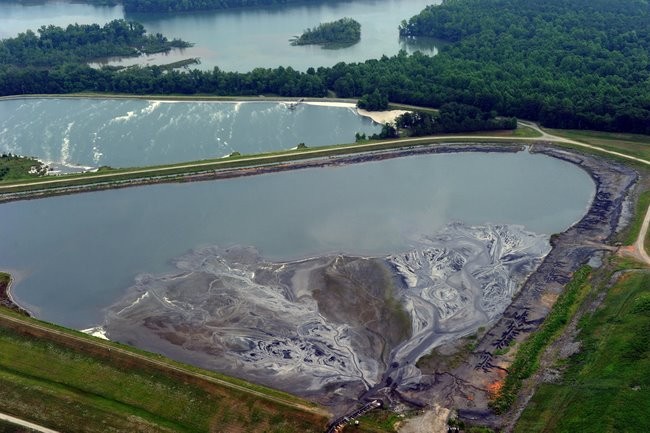
- Here are the two unlined, high-hazard coal ash ponds on Mountain Island Lake (aka our drinking water).Thanks to Nancy Pierce and Southwings for the photo.
The U.S. Environmental Protection Agency has been trying to classify coal ash as hazardous waste for more than three decades. Each and every time, though, they're blocked by powerful Washington lobbyists working on behalf of the energy, coal and waste industries.
Problem is, coal ash is a big, bad problem. North Carolina has more unlined, high-hazard coal ash ponds than any other state. ("High-hazard" means should the earthen dams that hold coal ash ponds in place fail, it's likely people will die.)
There are four unlined, high-hazard coal ash ponds just up the road from Uptown Charlotte, and two of those are on the edge of our city's main drinking water source.
We know the groundwater near the unlined, high-hazards ponds is contaminated. We know, from Duke Energy's own record keeping, that the run off from the coal ash ponds — which pours into the Catawba River system (a.k.a. our drinking water) 24/7/365 — contains heavy metals and toxic substances like arsenic.
So, why are our representatives in Washington voicing "strong opposition" to the EPA's proposed coal ash rule?
From the Center for Public Integrity:
The Center’s probe revealed the havoc that coal ash has wreaked on the environment and on human health near ponds, landfills, and pits where ash gets dumpedwhile a debate over federal regulation dragged on for decades. That debate flared again after the disastrous December 2008 coal-ash spill in Eastern Tennessee, a spill which led EPA to pledge to finally regulate the waste, which is a toxic byproduct of burning coal to produce electricity.
In May, after months of behind-the-scenes politicking over its proposal, the EPA unveiled a 563-pagedraft plan that would essentially classify coal ash as “hazardous” under federal waste law, triggering a series of strict controls for its dumping. A second option included in the EPA plan would deem coal ash “non-hazardous” and subject it to less stringent national standards amounting to guidelines for the states.
Political pressure against regulating the ash has been mounting ever since, and includes several Democrats on the House energy panel and in the Senate.
In a letter to EPA Administrator Lisa Jackson, 31 members of the House energy committee — nine Democrats and 22 Republicans — said the hazardous approach “could destroy jobs and increase electricity rates.” The letter argued that the label would “stigmatize” and “deal a crippling blow” to the recycling of coal ash into such products as cement. And it warned of potentially higher costs to utilities and consumers, citing an industry group’s predicted loss of 14 percent of the U.S. generating capacity as a result of stricter regulation.
“Closure of that amount of capacity would create reliability problems for the electric system and would cause electricity rates to increase unnecessarily,” stated the July 29 letter, which was organized by Democratic Rep. Rick Boucher. His home state of Virginia has two of the 63 cases identified by the EPA nationwide where coal ash may have tarnished groundwater and harmed ecology.
A similar letter, circulated by Sens. Kent Conrad and Byron Dorgan, two Democrats from North Dakota, and signed by 33 other senators, has also been sent to EPA’s Jackson.
Environmental advocates say the lawmakers’ arguments echo almost word for word the utility industry’s letters to the EPA opposing its coal ash waste plan.
The letters are also reminiscent of those decrying a draft determination backing the hazardous approach put forward by the EPA in 2000, when the agency appeared on the verge of proposing stricter federal controls for coal ash. Ultimately, it was fierce industry lobbying and political pressure that prompted the agency to back away from the hazardous option and instead pledge to issue the non-hazardous guidelines, a pledge that languished during the Bush administration.
“They brought up the stigma and cost arguments in 2000, and they’re bringing it up now,” says Lisa Evans, an EarthJustice attorney who has battled for federal regulations of coal ash. She notes that, in its current proposal, the EPA has found that both the cost to consumers and to the recycling industry are negligible. At the same time, the agency has uncovered more data proving the toxicity of coal ash. Not to mention all the human health and environmental devastation the lack of regulations has caused across the country.
“I’m pretty convinced that a lot of these legislators would have been more hesitant about signing onto this letter if they had heard from us first,” says Steve Slesinger, of the Natural Resources Defense Council, which supports the EPA’s current proposal.
Read the entire article here.
In news you can use, the EPA is coming to Charlotte next month specifically to talk about coal ash. Find out more about the hearings, and how you can sign up to speak at them, here.
